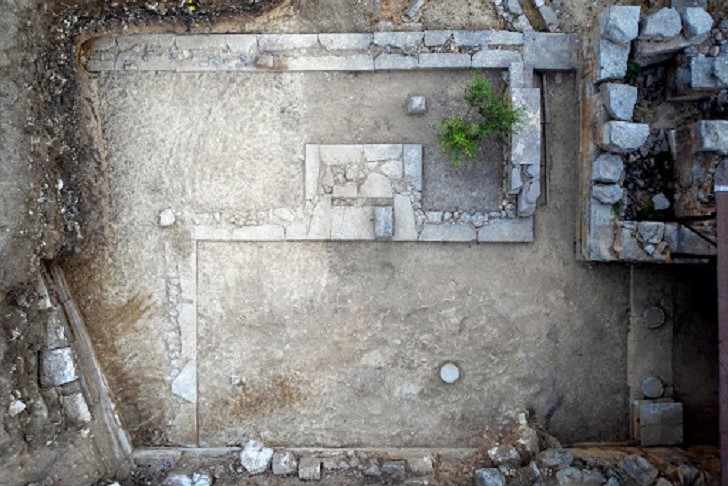The recent discovery of a sacred gate at the Minoan Palace of Archanes on Crete has captivated archaeologists and historians, revealing unprecedented insights into the Minoan civilization’s religious practices. The gate, the first of its kind found in a Minoan palace, offers a glimpse into ancient ceremonial life on the island. Located just south of the main entrance to the palace, this unique structure contains four altars and two arms of a stone platform, each meticulously designed with distinct architectural features.
The Sacred Gate Structure and Religious Purpose
The sacred gate at Archanes stands as more than a mere entryway; it serves as a site of ritual and worship. The structure featured two stone arms, each connected to a platform with a pyramidal base on one side and a partially preserved base on the other. This design likely had spiritual significance, guiding participants through ceremonial practices.
The presence of multiple altars surrounding the gate further emphasizes its importance in Minoan religious life, suggesting that priests or attendants performed rituals in close proximity to the palace entrance, where worshippers could gather.
Discoveries of Unique Altars and Sacred Artifacts
During the excavation, archaeologists uncovered four distinct altars, each seemingly designed for different ceremonial purposes. Among these was a large oblong altar and a stepped altar, possibly symbolizing different deities or functions within Minoan worship. A stone base, buried under massive stones to the south of the entrance, suggests that this area had a dual sacred function.
Artifacts found alongside the base include remains of burned wood and four bronze hooks, believed to have been used as supports for a wooden plinth. The discovery of these items suggests that an upper-level room above the altar may have had an elevated sacred status, reinforcing the palace’s strong religious ties.
Archanes Palace: A Center for Spiritual and Administrative Power
Built around 1900 B.C., the Palace of Archanes served as a significant religious and administrative center, likely under the influence of the grand Palace of Knossos, located just five miles to the north. While Knossos remains famous for its labyrinth and mythical association with the Minotaur, Archanes played a crucial role in overseeing fertile agricultural land and managing local religious activities.
Its multi-story structure included various sanctuaries, a theater, and dedicated spaces like the sacred gate, pointing to the palace’s integral role in Minoan society. The discovery of hundreds of religious artifacts, from ritual vessels to figurines, attests to the site’s centrality in Minoan religious practices.
The Sacred Role of the Upper Floors and Architectural Mysteries
The excavation of Archanes Palace revealed more than ground-level artifacts; it also uncovered elements pointing to the sacred nature of the upper floors. In a room adjacent to the courtyard, researchers discovered evidence suggesting that a sacred chamber existed above the altar room.
The burned remains of a wooden plinth, supported by the bronze hooks, add to this theory. This elevated sacred space could indicate that the palace had hierarchically arranged religious areas, with ceremonies or rituals conducted in more exclusive, elevated locations. This architectural arrangement offers insight into the complexity of Minoan religious hierarchy and spatial organization.

Credit: eKathimerini.com | The excavation of Archanes Palace uncovered elements pointing to the sacred nature of the upper floors.
Mycenaean Influence and Destruction of the Minoan Palace
The palace’s history doesn’t end with the Minoan civilization; it also reflects the turbulent times of the Mycenaean conquest around 1450 B.C. When Greek mainlanders from Mycenae took over Crete, they repaired and reused Minoan structures, including palaces like Archanes. Evidence suggests that the palace experienced significant destruction during this period.
Massive stones, found with traces of fire damage, illustrate the event's intensity, marking a chapter of violence in Archanes' history. Artifacts from this Mycenaean layer are few and fragmented, underscoring the destructive nature of their conquest. Yet, the Minoan cultural footprint, such as the sacred gate, endures, providing insights into how religious practices may have persisted, even under Mycenaean influence.
A Glimpse into Minoan Spiritual Legacy
The Palace of Archanes, with its sacred gate and intricate architecture, reveals a unique view of Minoan society. It reflects a civilization deeply devoted to spirituality, with structured spaces for ceremonies and worship. This discovery, paired with other excavations at the palace, highlights a fascinating blend of religious purpose, architectural sophistication, and historical resilience.
The sacred gate discovery at Archanes offers an enduring testament to the complex spiritual life of the Minoans. Through these findings, we gain a deeper understanding of ancient Crete, from its powerful religious rituals to the resilience of its sacred spaces.




